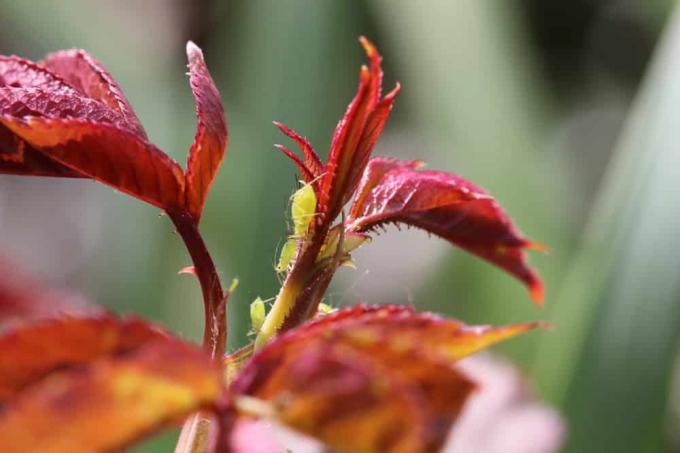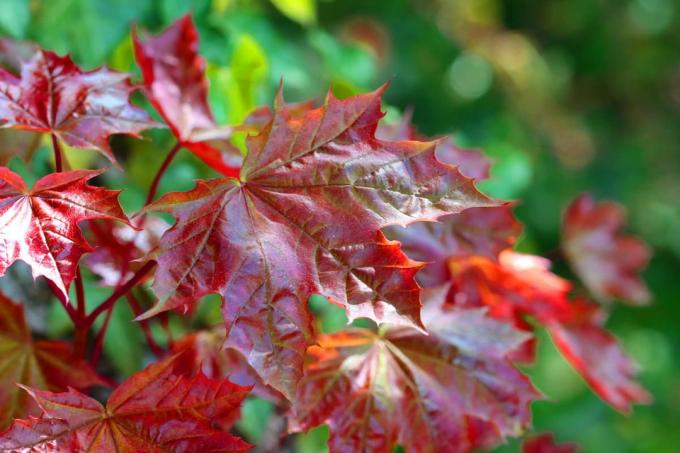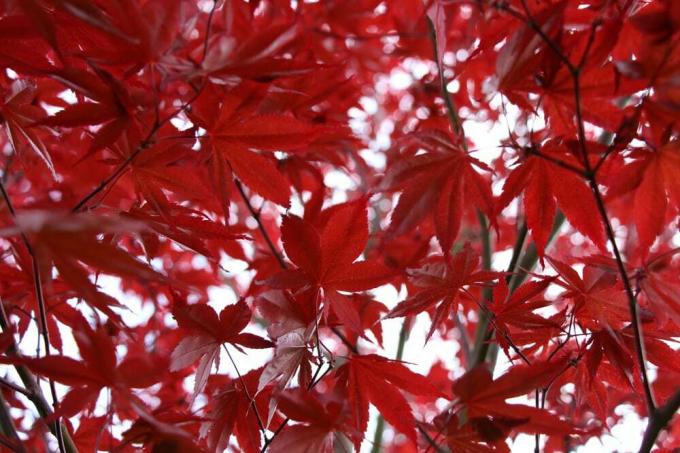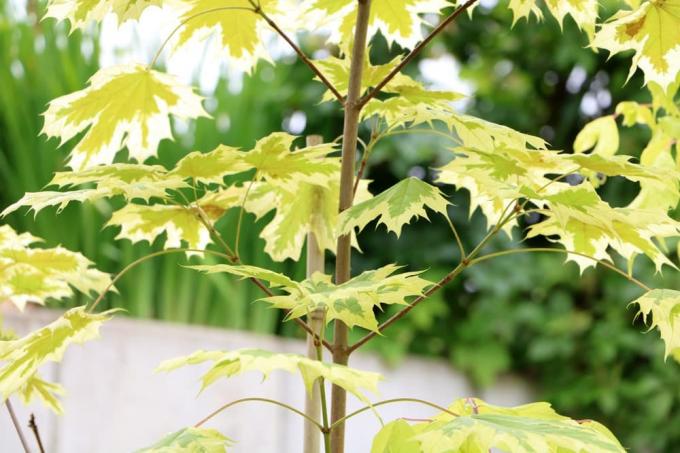

Table of contents
- Which pests overwinter on the wood?
- What is meant by a sprouting spray?
- How does the injection work?
- Where are the limits of effectiveness?
- Is squirting harmful too?
- When does the sprouting spray have to be done?
- Clearly determine pest risk
- Instructions for sprouting spray
Many pests overwinter on fruit trees. These include aphids, scale insects, spider mites and various types of windworms. As soon as the weather warms up in spring, they wake up from their hibernation and get to work. Then they can hardly be stopped. Can the sprouting spray kill these pests before they do much damage? If so, when and how does it have to be done to be really effective?
Which pests overwinter on the wood?
Many species of insects and mites overwinter on the wood. However, these are not adult specimens, but their eggs or eggs. larvae. These include the following pests:
- aphids
- blood lice
- scale insects
- sit calle lice
- spider mites
- frost moth
- spider moths
- different types of winders
Many pesticides promise effective control of these pests by early spraying of the shoots.
What is meant by a sprouting spray?
Many pests usually lay their eggs directly on fruit and ornamental trees, which serve as a food source for them in the warm season. Sometimes also on other, neighboring trees. The eggs or Larvae overwinter on branches and twigs. In the following year, they strike again as soon as the temperatures get warmer and budding begins. Sprout spraying is spraying on the trees with the aim of destroying the wintering pests with a suitable spray while they are still dormant. Since this spraying coincides closely with the budding of the trees and shrubs, it is therefore referred to as budding spraying.
How does the injection work?

In the past, the sprays used to spray shoots were highly toxic. Many oil-based preparations are now commercially available. This is usually a mineral oil or vegetable rapeseed oil. An emulsifier is also added so that the oil dissolves in the water. The spray has the same effect on pests, regardless of the stage of development. When the pests are about to hatch, the eggs are particularly permeable. The oil from the spray lays like a film over the eggs and kills them. Caterpillars that hibernate in the cocoon or that have already hatched suffocate from the oil because it clogs their respiratory organs. This also applies to adult sitcal lice, which are already active in winter.
Where are the limits of effectiveness?
Spraying can have a preventative effect against insects and mites. Unfortunately, these are not the only danger for the trees. Diseases caused by fungal pathogens can be combated or prevented with it. Powdery mildew, monilla and blackspot remain completely unaffected by a sprouting spray and can spread unhindered. Here other control methods must be used.
Is squirting harmful too?
Pesticides are used specifically against specific pests. But their devastating effect is not limited to just that. In addition to the pests, many so-called beneficial insects also overwinter on the fruit trees. Beneath the protective bark are helpful predatory mites, earwigs and various species of parasitic wasps. They are also caught by the sprouting spray. The already hatched and early active ladybirds and lacewings also suffer from sprouting spray. Likewise, some species live on the trees that are neither harmful nor useful.
Tip:
Due to these disadvantages, spraying should only be considered if many pests are to be expected in the new garden year. For example, because there was already a pest plague last year. Then it can be assumed that there are many eggs and larvae on the trees.
When does the sprouting spray have to be done?
The right time for the sprouting spray is crucial so that it can develop its full effect. On the one hand, the pests must be destroyed and, on the other hand, the budding must not suffer.
- Sprout spraying takes place in the months of March to April
- the time window for this is about 14 days
- as soon as the buds swell
- depending on the weather
- no night frosts should be expected
- dry during the day, with temperatures around 14 degrees
- do not spray on and before rainy days
A notice:
When the first leaf tips are already visible, spraying is no longer allowed. The oil contained in the spray damages the wax layer of the young leaves. However, this layer is important because it performs a protective function.
Clearly determine pest risk

The sprouting spraying is associated with costs and workload. Furthermore, it also brings disadvantages, such as the destruction of beneficial insects. Therefore, before using this control method, it should be clarified whether there are any overwintering pests on the trees and shrubs.
- Examine the bushes closely
- Search sheltered hiding places
- Cracks, bud scales, wounds etc. ä.
- Aphid eggs are oval, about 0.4 mm long and shiny black
- Spider mite eggs are brick-red, spherical, 0.1 mm in diameter
- orange-red, barrel-shaped eggs with approx. 0.7 mm in length are from Frost Moths
Here, too, it should be noted that the sprouting spray only makes sense if a large infestation is likely. Used simply as a preventative, it can do more harm than good.
Tip:
If the number of trees and shrubs is small, many pests can also be "sprayed" off the trees with a hard jet of water at a later point in time. For a small home garden, this is a viable and environmentally friendly method.
Instructions for sprouting spray
If you have found pest eggs on your trees and bushes that can be successfully combated with shoot spraying, proceed as follows:
- Obtain a suitable oil-based pesticide from a specialist dealer.
- Regularly inspect the trees to determine the best time to spray the shoots.
- First, use a brush to remove any loose pieces of bark.
- Prepare the spray mixture. It is essential to observe the manufacturer's dosage information and safety instructions.
- Spray one after the other all trees and shrubs on which you have previously discovered clear indications of the corresponding pests. In no case do not spray all the plants indiscriminately.
- Thoroughly spray the trunk, all branches and twigs from all sides until dripping wet.
Tip:
Work slowly, very thoroughly and do not leave out any parts of the plant. Only in this way can the sprouting spray bring the desired success. Spraying is particularly easy to do with a backpack sprayer.
 garden editorial
garden editorial I write about everything that interests me in my garden.
Find out more about A for maple

What are stolons and stolons?
As an offshoot or Stolons (singular: stolo) are appendages of plants that can continue to exist independently after being severed. Foothills are used for reproduction. Some foothills develop above ground, others underground.

Japanese maple, Acer palmatum: care, pruning and more
The Japanese maple impresses with its large but filigree leaves with extraordinary autumn colors. It does not make any special demands on care, but is considered to be somewhat picky about soil and location. Small varieties can also be cultivated in tubs.

Red maple: 9 tips for caring for, cutting & overwintering
The red maple is one of the most impressive trees in Germany due to its unusual scarlet leaf colour. Here you can find out how to integrate this impressive plant into your garden and how to keep it healthy and vigorous.

Red Norway Maple: Basic Care | Red-leaved maple
Red maple is well on the way to overtaking its green-leaved counterpart as a popular house tree. This guide will acquaint you with the basics of care so that the red-leaved premium variety can make the most of a representative welcoming committee in the garden.

Is the Japanese maple hardy? This is how you overwinter it properly
The Japanese maple is so popular in the local latitudes because it can be cultivated in the garden and in a bucket. Because the tree has its origin in the Japanese mountain regions, where there is a similar climate. It is therefore not difficult to get the plant through the winter well.

Pruning instructions for the maple - How to cut it correctly
A spherical maple does not keep its round, compact crown by itself. Without pruning at fixed intervals, the decorative shape will be lost over the years. The point in time is no less important than the incision. These instructions explain in detail when and how to properly cut the elegant ornamental tree.
